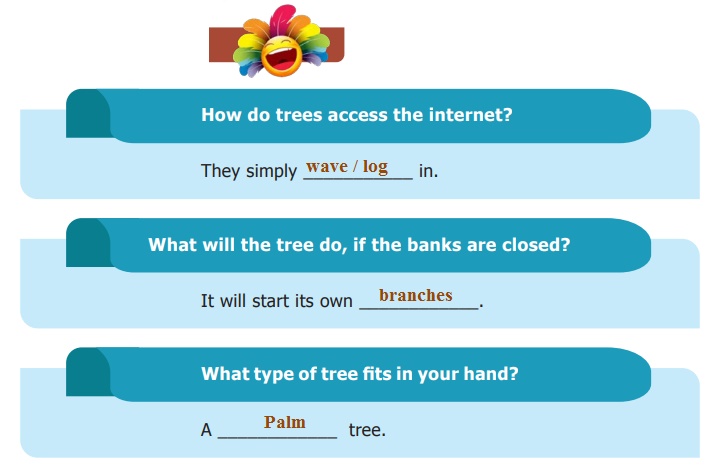English : Unit 3 : Poem : On Killing a Tree – by Gieve Patel
Warm up
1. What is a tree?
A tree is a tall plant that has a hard trunk, branches and leaves.
2. Why trees are important for our survival?
They give us oxygen, store carbon, stabilise the soil and give life to world’s wild life. They provide us timber for tools and shelter.
3. How long does it take a tree to grow to its full size?
Some trees are slow growers which take 20-30 years. Some are fast scavers take 10-15 years.
4. How much time does it take to cut down a tree?
It does not take much time with all technical advancement it can be cut down very quickly. It may hardly take an hour.
Glossary
jab (v) : to poke, or thrust abruptly or with a short, quick blow
crust (n) : the brown, hard outer portion or surface
leprous (adj) covered with scales
hide (n) the strong thick outer skin
miniature (adj.) : very small
A. *Memorize the first two stanzas of the poem.
It takes much time to kill a tree,
Not a simple jab of the knife
Will do it. It has grown
Slowly consuming the earth,
Rising out of it, feeding
Upon its crust, absorbing
Years of sunlight, air, water,
And out of its leperous hide
Sprouting leaves.
So hack and chop
But this alone wont do it.
Not so much pain will do it.
The bleeding bark will heal
And from close to the ground
Will rise curled green twigs,
Miniature boughs
Which if unchecked will expand again
To former size.
B. Read the following lines from the poem and answer the questions in a sentence or two.
1. It takes much time to kill a tree,
Not a simple jab of the knife Will do it.
i. Can a ‘simple jab of the knife’ kill a tree?
No, a simple jab of the knife cannot kill a tree.
ii. Why does it take much time to kill a tree?
Because the tree is very strong and its root is deep in the earth.
2. It has grown
Slowly consuming the earth,
Rising out of it, feeding
Upon its crust, absorbing
i. How has the tree grown?
The tree has grown slowly.
ii. What does the tree feed from the crust?
The tree feeds water from the crust.
3. And out of its leprous hide
Sprouting leaves.
i. What does the phrase ‘leprous hide’ mean?
‘Leperous hide’ means the bark of the tree. It has rough skin with scales.
ii. What comes out of the leprous hide?
Tiny leaves comes out of the leperous hide.
4.The bleeding bark will heal
And from close to the ground
Will rise curled green twigs,
Miniature boughs
i. What will happen to the bleeding bark?
The bleeding bark will heal.
ii. What will rise from close to the ground?
The curled green twigs will rise from close to the ground.
5. The root is to be pulled out –
Out of the anchoring earth;
i. Why should the root be pulled out?
The root should be pulled out to dry it and kill the tree.
ii. What does ‘anchoring earth’ mean?
‘Anchoring earth’ means fixing the tree firmly inside the earth (like a ship in the sea).
C. Based on the understanding of the poem, write down the summary of the poem by filling in the blanks.
The poet explains the process of killing a tree. A lot of work has to be done in order to kill it completely. It cannot be accomplished by merely cutting it with knife. The tree has grown strong with the help of the earth, sunlight, water for countless years. Even the branch of the tree gives rise to boughs. The bough sprouts new twigs and leaves. In a short period, they grow into a new tree. So, to kill a tree completely, one should take out its roots completely from the soil. Then they should be exposed to the sun and air. Only then the tree will be completely killed.
D. Based on the understanding of the poem, answer the following questions in a sentence or two.
1. What is the poem about?
Answer: The poem is about the killing of a tree.
2. What are the lessons to be learnt from the poem?
Answer: We must grow trees and protect them. We must not kill the trees. We must be eco-friendly.
3. What are the life sources needed for a tree to grow?
Answer: The sources needed for a tree to grow are the earth, the sunlight, the air and water.
4. What does the poet mean by ‘bleeding bark’?
Answer: By bleeding bark, the poet means that the bark bleeds when it is cut with a knife.
5. Why does the poet say ‘No’ in the beginning of the third stanza?
Answer: It is not so easy to kill a tree. The root must be pulled out. Thus the poet say ‘No’ to all the wood cutter.
6. How should the root be pulled out?
Answer: The root should be roped, tied and pulled out of the anchoring earth.
7. What is hidden inside the earth for years?
Answer: The roots are hidden inside the earth for years.
8. What finally happens to the tree in this poem?
Answer: The tree is totally exposed to the sunlight and air. Thus it is killed completely.
E. Answer the following questions in about 80-100 words.
1. How does the poet bring out the pain of the tree?
Title : On killing a tree
Poet : Dr. Gieve Patel
Character : Tree, wood cutter
Theme : “Thou shall not kill” (even a tree)
The poet compares the killing of a tree with the killing of a man. The poet imagines the feeling of the pain by the tree. A tree has life and it is sensitive. A sharp knife must give some severe pain to the tree. It is hard to cut. The bark of the tree bleeds when the cut is deep. The tree endures pain but still it has life. The root of the tree is like the heart of man. A man dies only when the heart is damaged. Like wise a tree struggles to hold its life until it is uprooted. The root has anchored in the earth and stands straight and firm on the earth. The tree undergoes all unspeakable pain when it is felled. Though it does not cry but mankind may try to feel and be kind to it.
“Killing a tree is like killing a man”
2. ‘A tree doesn’t grow in a day.’ Explain it with reference to the poem.
Title : On killing a tree
Poet : Dr. Gieve Patel
Character : Tree, wood cutter
Theme : “Thou shall not kill” (even a tree)
Trees are the bigger plants. They live long. The trees have a long span of life. Any plant that grows over night may not live long. The trees with lower density grow faster than the trees with greater density. Insects cannot easily damage the latter ones. Some trees are slow growers which take 20-30 years. Some are fast growers and they take 10-15 years. As the saying goes, “It’s worth, the wait”, they do eventually. Trees grow slowly but steadily. Their roots go very deep anchoring the earth. The trunk of it is very strong with many branches and leaves. Their uses are many but many fail to know. Certain trees take a few decades to grow. Thus it is clear that a tree cannot grow in a day.
“Rome was not built in a day”
3. Why do you think the poet describes the act of cutting a tree? What effect does it have on you as a reader?
Title : On killing a tree
Poet : Dr. Gieve Patel
Character : Tree, wood cutter
Theme : “Thou shall not kill” (even a tree)
The killing of a tree is a cruel act. The poet has made us realise that felling of a tree is killing it. The word “Killing” is very effectively and earnestly used in the poem. A man dies when the heart is affected. Similarly a tree becomes lifeless when its root is removed from the earth. The root of a tree is compared to the heart of a man. The poem teaches a lesson to the readers that we must be kind towards any living thing, either a tree or man. Killing a tree means killing a human being. Thus it is clear that the poet wants the readers to be kind to living things. As readers we must feel the pain for killing the tree.
“Let us not fell the trees before they fall”
COMMON PARAGRAPH
PARAGRAPH FOR TOPPERS:
Synopsis:
• Introduction
• Killing is not easy
• Cut tree grows
• Strong tree
• Death of the tree
• Conclusion
Introduction:
“On killing a tree” describes the difficulty of cutting down a tree. The poet writes about nature, strong and life time of the tree.
Killing is not easy:
The poet tells us that killing a tree is not easy. It takes time. It takes in years of sunlight, water and air. The tree has many branches and the leaves are lengthy.
Cut tree it grows:
The part of the tree is wounded. It will heal. New branches will grow again. New barks are fresh and grow gradually.
The root:
The root is the source of tree. The root is hidden in the earth. The root is sensitive. If the root is wet and white, the tree becomes weak.
Death of the tree:
The tree is exposed to sunlight and air. The root becomes dry and hardened. Then finally the tree is dead.
Conclusion:
The poet brings the focussing of destruction of trees and deforestation. The poet draws our attention to “No trees, No life”.
PARAGRAPH FOR AVERAGE STUDENTS:
The poet tell us that killing a tree is not easy. It takes time. It takes in year of sunlight, water and air. The trees has many branches and the leaves are lengthy. The part of the tree is wounded. New branches will grow again. The root is the source of tree. The root is hidden in the earth. The root is dry, the tree becomes weak. Then finally the tree is dead.
PARAGRAPH FOR LATE BLOOMERS:
• The poet tells us that killing the tree.
• It is not easy.
• It takes time.
• The tree has many branches and leaves.
• The part of the tree is wounded.
• New branches will grow again.
• The root is the source of tree.
• The root is dry, the tree becomes weak.
• Then finally the tree is dead.
F. Complete the table by identifying lines, against the poetic devices from the poem.
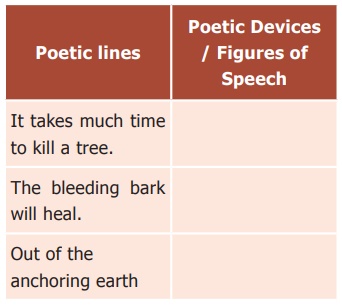
Solution:
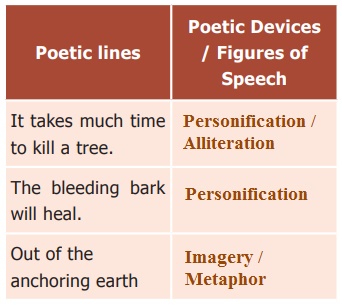
LISTENING
G. Listen to the passage about Nammazhwar, an environmental crusader from Tamil Nadu. As you listen, answer the following questions. The listening act can be repeated if required.
Nammazhwar was born in 1938 in Elangadu, Thanjavur District, and he graduated from Annamalai University with a B.Sc. in Agriculture. In 1963, he began working for the Agricultural Regional Research Station, a government organisation in Kovilpatti, as a scientist, conducting trials on spacing and use of various chemical fertilizers in cotton and millet crops. During his tenure there, the government had conducted various experiments in rain-fed land, using expensive inputs like hybrid seeds, chemical fertilizers and chemical pesticides which Nammazhwar considered futile as the farmers were resource poor. Based on his experience, he felt very strongly that it was imperative to totally reorient the research work being undertaken. But his peers at the institute paid little attention to his advice. Frustrated, he left the institute in 1969.
For the next 10 years, he was an agronomist for Island of Peace, an organisation founded by the Nobel Laureate Dominique Pire. His focus was on improving the standard of living through agricultural development in the Kalakad block of Tirunelveli District, Tamil Nadu. It was at this time that he realised that to get optimal results in farming, farmers should rely only minimally on external inputs. All inputs should come from within the farm. So called waste should be recycled and used as input. This revelation was a turning point in his life. He completely lost trust in conventional farming practices and began experimenting with sustainable agricultural methods.
Vegetables have a short lifespan compared to fruit crops. By making use of modern technologies and inputs, their lifespan can perhaps be extended to say about a year. But if there is a simple method of growing vegetables throughout the year, without any costly gadgets, modern technologies, or costly inputs, it is definitely worth a try for the farmers.
He advocated the ‘Bread sandwich’ method. In this method once the soil is made ready and the suggested practices followed, one need not work on the soil for the second time. They can go on sowing and reaping, all through the year.
He always said it was no use trying to teach a farmer. Instead, one should make the farmer understand the issue. He never stopped learning from them himself and had become a vast repository of farming practices and knowledge that he shared with whoever was interested. He never pushed ideas down anyone’s throat. Each farm is unique according to the farmers’ understanding and the conditions, Nammazhwar would say. He would keep experimenting with what he learned from the farmers, refined this knowledge and then gave it back to them.
He often said “Farming is not a way of producing crops to make money. It is a way of living, and a way of living that is possible even in the 21st century.” He trained hundreds of farm youths as trainersand helped many farmers to be master trainers—all this without the support of the government.
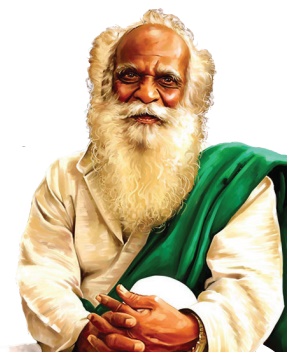
1. Who is Nammazhwar? What is his contribution to farmers and farming?
Nammazhwar was a graduate in agriculture. His contribution was that all inputs must come from within the form and the waste should be recycled and used as input.
2. In 1963 he worked for the Agricultural Regional Research Station, a government organization in kovilpatti, as as a scientist.
3. What was the turning point in the life of Nammazhwar?
The revelation of recycling the waste to be used as an output in farming was his turning point.
4. How is the “Bread sandwich method” a boon to the farmers?
The soil is made ready and the suggested practices followed without working on the soil for the second time. The farmers can go on sowing and reaping throughout the year. This is the boon to the farmers.
5.Pick out ideas from the passage to show that he learnt first and then shared with farmers.
He never stopped learning from the farmers. He became a vast repository of farming practices and knowledge. He never pushed ideas down anyone’s throat. According to the farmer’s understanding and conditions each farm is unique.
6. Explain in your own words the meaning of “Farming ___________ even in the 21st Century”
Farming is not for making but a way of living and it is possible in the 21st century.
7. Give the synonyms of ‘rely’ and ‘sustainable’.
Synonyms of ‘rely’ is depend
Synonyms of sustainable is maintainable
8. “He never pushed ideas down anyone’s throat” means
(a) favoured
(b) compelled
(c) opposed
Answer: b) Compelled
WRITING
H. Based on the reading of the poem, complete the web chart given below.
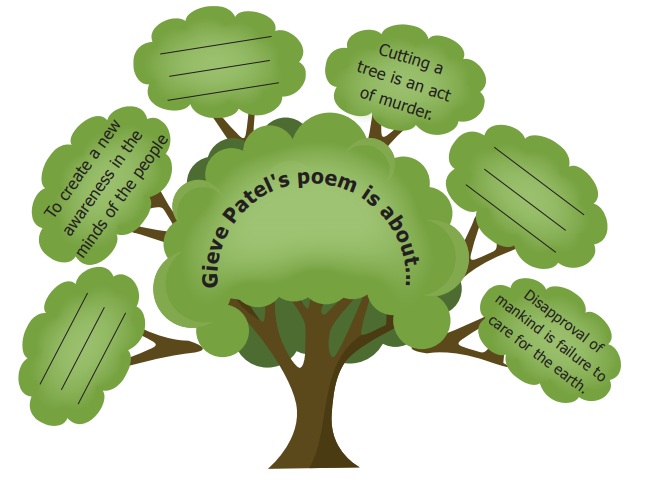
Cutting a tree is an act of murder.
Failure to preserve the forest.
To create a new awareness in the minds of the people
Lack of co-friendly attitude.
Disapproval of mankind is failure to care for the earth.
Deforestation and destruction of nature
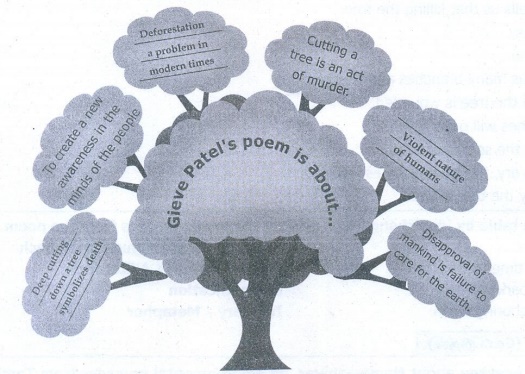
I. Look at the two trees. One is a green flourishing tree and the other, a brown withering tree.
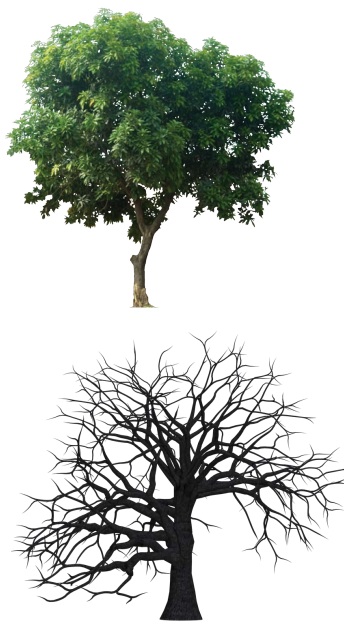
The class will now be divided into two groups. Group A will list down the agents that support a tree’s growth. Group B will list down those that prevent it. Once the groups are ready with their lists, a few representatives from each group will write down the lists on the black board.
Taking clues from the lists on the board, complete the following chart.
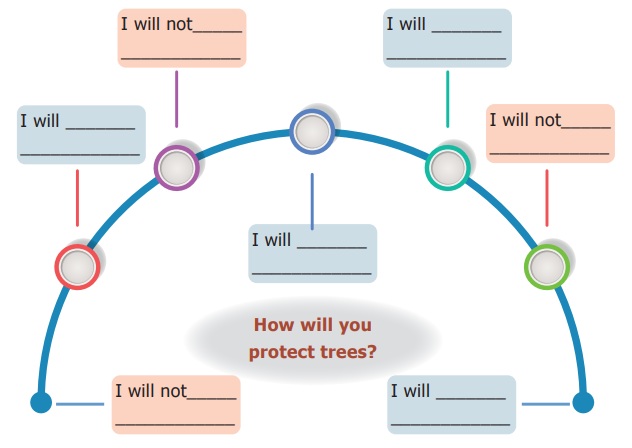
Solution:
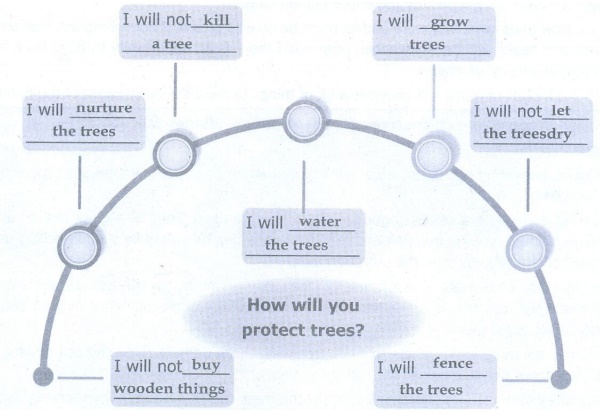
J. Work in pairs. Create three slogans on ‘Saving Trees’.
Remember
* Use catchy, meaningful phrases.
* Do not write complete sentences.
* Ensure that the words at the end rhyme.

Answer:
1.”Save the tree and have the air fresh”.
2.”Make not trees rare; keep them with care”.
3.”Trees on; Global warming gone”.
SPEAKING
K. Deliver a short speech for about five minutes on the following.
1. Imagine what will happen if all the trees in the earth disappear. Discuss with your friends and share it with your classmates.
Dear friends,
If all the trees on the earth disappear ail on a sudden, the earth will lose its charm. A lot of harm will follow us definitely. When there are no trees, there will be no forest on the earth. The landscape will not be enchanting our eyes. The beautiful earth will turn to be a barren earth.
The trees gives us oxygen. They take in the carbon-di-oxide. For want of oxygen, the human health will start deteriorated. This will definitely result in a heavy loss of life. The wild life will become extinct.
The disappearance of trees will ban the rain. Even the seasonal rain will become much less. As a result of it, there will be an acute scarcity of water. The water resources will become dry. Without water, the survival of human, bird and animal.
Scarcity of water will affect agriculture as it depends mainly on water. Even there will be a threat for drinking water. There will be drought and famine will prevail the earth. Global warming will affect the ozone layer further. This will destroy the entire human race.
Let us grow trees more and more and let there be no wild dream of not having any tree on the earth. Our growth and health will be sustainable, only when there is an opportunity to have thick forests and ever green trees around us always.
Trees are friends of human. It provides a lot of things to meet the basic needs of the human society.
2. Think of a situation where all the trees can speak. What will they talk about?
Dear mates,
It is quite interesting and awesome to think of a situation like this. If all trees start speaking, we may have to be spell bound.
The trees may speak about their goodness and benefits to us. They do a great deal to us. They will tell that they help us breathe fresh air and lead a healthy life. They may be proudly telling us that they provide us shade to save us from the scorching sun.
They may ask us to water them regularly. They may tell others or the fellow trees if they are not taken care of. They may tell us not to harm them if we tend to cut the branches or the tree itself, They may plead us not to kill them.
They may tell us to plant more and more trees and make domestic and civilized forests. They may tell us to have more rain to increase the water resources.
It would be very thrilling and amazing when the trees can speak the human tongue. Let us talk to the trees and listen to what they want to tell us.
Let us laugh together
